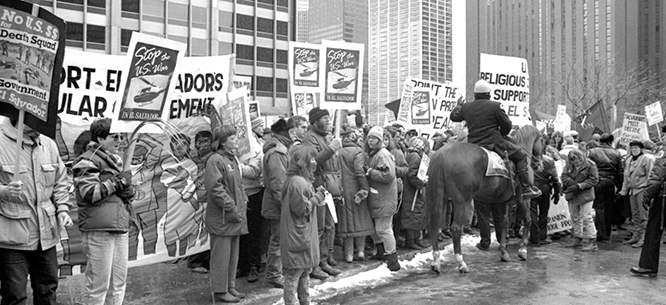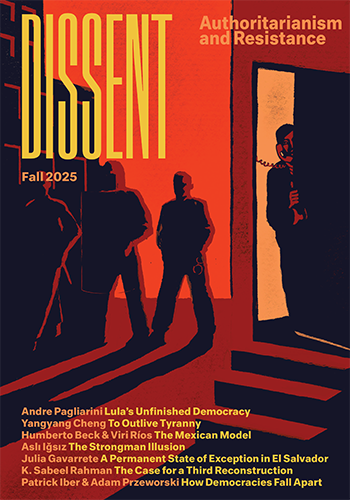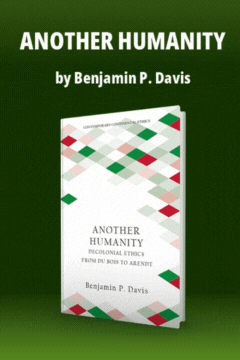The Future of Sanctuary
The Future of Sanctuary
Sanctuary activists face new challenges under Trump’s second term but their work has always entailed great personal risk.

In the summer of 1984, a caravan of vehicles full of religious activists sped across the United States. Moving from Tucson to Los Angeles to Denver and finally ending in Detroit, this self-styled “Sanctuary Freedom Train” was transporting a Salvadoran family of four that had fled their war-torn country and arrived in the United States seeking political asylum. Raul and Valeria Gonzalez had escaped with their two children after Raul, a teacher, had been arrested and beaten by government soldiers and threatened with worse if he were to continue his literacy work among the country’s poor. The Gonzalez family found refuge in Detroit’s St. Rita’s Catholic Church, where people of faith had pledged to offer sanctuary to migrants who had been unduly denied asylum by the American government. Once settled in his new temporary home, Raul became an organizer himself, inviting congregations across the country to join a national movement for migrant justice. As he noted a year after disembarking the Sanctuary Freedom Train, “solidarity is doing whatever is needed to stop the suffering of others.”
Over the last forty years, immigration and refugee justice activists have adopted and adapted the practice of sanctuary as a form of solidarity, sheltering undocumented individuals and families who have exhausted all legal recourse to remain in this country. What began as a faith-based movement has grown into an all-encompassing effort to transform cities, schools, and other public spaces into locations free from the specter of an ever-encroaching detention and deportation apparatus. The municipalities that have declared themselves “sanctuary cities”—a term first embraced by activists in cities like San Francisco, Chicago, and Los Angeles in the 1980s—have adopted a number of different policies, the most important of which are noncooperation agreements, which limit how authorities within a given jurisdiction can work with federal immigration enforcement. Whether it’s in a church pew or on a city street, advocates of sanctuary have embraced a communal ethic of radical hospitality toward those forced to the margins of society. Their work evokes the words of Jim Corbett, a founder of the 1980s sanctuary movement: “Individuals can resist injustice, but only in community can we do justice.”
The re-election of Donald Trump has presented a wave of new obstacles for sanctuary activists. In just the first few weeks following his inauguration, Trump moved to make good on campaign promises to make life untenable for refugees, visa holders, and undocumented residents alike, signing executive orders that declared a national crisis at the U.S.–Mexico border, expanded the number of people who are deportable, and constrained the country’s asylum laws. He’s found ready allies among Republicans in Congress, who have taken up the charge of rooting out sanctuary policies by calling the mayors of Boston, Denver, New York City, and Chicago before the House Oversight Committee in highly publicized hearings. Perhaps most troubling for sanctuary advocates has been Trump’s rescinding of the “sensitive locations” memo, an executive policy that discouraged immigration agents from entering hospitals, schools, and houses of worship. Within a week of the rescission, ICE agents appeared at a Latino Pentecostal church outside of Atlanta, engaged the ankle monitor of the church founder (who had an open asylum case), and arrested him as soon as he stepped outside of the church. All of these moves seem to call into question the very essence of the protection sanctuary has sought to provide: that the church can serve as a steady and reliable bulwark against what historian Adam Goodman has dubbed the “deportation machine.”
What future does this long lineage of sacred resistance have in an America marked by growing animosity toward undocumented residents?
The origins of sanctuary movements can be traced to the 1980s, when the United States carried out proxy wars across Central America in an effort to stem the tide of communism. The Reagan administration provided funds, arms, and training to dictators who promised to quash revolutionary efforts, and the results were devastating: millions of civilians found themselves in the crosshairs of death squads and secret police charged with ferreting out any subversive behavior. Thousands of Salvadorans and Guatemalans fled the violence in their countries, but the United States refused to recognize people displaced by the conflicts as refugees.
Incensed by this abdication of not only U.S. and international human rights law but also a higher law to extend welcome to the stranger, congregations in border states like Arizona and California risked federal prosecution by offering sanctuary to Central Americans beginning in 1982. The initial declarations of sanctuary made public a practice that people of faith had been carrying out privately in the borderlands for years. Sanctuary organizers paired humanitarian aid to asylum seekers fearing detention with a concerted political education campaign, seeking to use their prophetic platform to educate Americans about their country’s complicity in the devastation being wrought in Central America. By the mid-1980s hundreds of houses of worship across the country had joined what historian Kristina Shull has called “the largest mass mobilization of civil disobedience against detention and deportation in US history.”
The sanctuary movement drew upon a deep well of religious hospitality, anchored in scripture and history. Participants cited a long lineage of “cities of refuge” in the Hebrew Bible and the New Testament and the presence of sanctuary churches in medieval Europe. They also sought to take the practice of sanctuary out of the church pews and into the streets by pushing their city councils to pass “sanctuary city” ordinances. When San Francisco officials drafted a sanctuary policy in 1985, the biblical allusion made it into the name: City of Refuge. Many participants also saw themselves as continuing the radical hospitality work of the nineteenth-century abolitionists who created the Underground Railroad to assist enslaved people pursuing liberty in the North. Sanctuary activists invoked these practices as they developed their own forms of both covert and visible systems to shield Central American refugees on their own flight to freedom.
These mobilizations drew the ire of the government. The FBI monitored and infiltrated the movement and began arresting sanctuary activists. This campaign culminated in the dramatic Sanctuary trial of 1985–86, when the Department of Justice sued the movement’s leaders. Ultimately, eight faith activists were convicted on charges of smuggling undocumented migrants into the United States. But while the Reagan administration may have won in court, the movement ultimately claimed the larger victory. In 1990, faith and civic groups successfully brought their own suit against the federal government and forced a settlement that allowed all Salvadorans and Guatemalans in the United States, including those who had seen their asylum cases rejected, to reapply under a fairer system.
Sanctuary remained dormant until the 2000s, when people of faith again turned to practices of sacred resistance to push back against a rising number of deportations under the Bush and Obama administrations. It was the 2016 election, however, that brought a dramatic upsurge in faith-based migrant activism. Many of those who engaged in a renewed form of sanctuary in the early Trump years were veterans of immigrant justice struggles, having fought for comprehensive immigration reform and humane border policies for decades. Between Trump’s election and 2018, the number of sanctuary churches and temples went from 400 to more than 1,100. As people across the country sought to fashion places of safe harbor for their immigrant neighbors, the movement spread to secular spaces as well. Echoing the work of 1980s activists, supporters of immigration and refugee justice pushed their city councils and state governments to pass policies that restricted the ability of local police to arrest residents for federal civil immigration violations or to collaborate with ICE. By the spring of 2019, dozens of cities and counties and ten states had introduced sanctuary policies. Similarly, college campuses witnessed a massive surge of sanctuary organizing within a matter of weeks of Trump’s first election. One petition tracker counted over 200 such petitions, which were met with mixed success.
While Trump railed against sanctuary cities in his first term, calling for Congress to ban them, faith activists took their message to a national audience. In Denver, for example, Jeanette Vizguerra, who had called this country home for decades despite lacking legal residency, publicly declared her immigration status and took refuge in a church. She criticized a hypocritical nation that benefited from her labor while refusing to offer her citizenship. Vizguerra, who was named in Time’s yearly list of the 100 most influential people in 2017, was one of many immigrant leaders who had been forced to find safe harbor in churches but who continued to fight for an immigration system that would uphold the worth and human dignity of every person in the country, regardless of their documentation status. She’s headed up organizations such as Abolish ICE Denver, the Metro Denver Sanctuary Coalition, and Sanctuary4All, and has supported numerous human and immigrant rights organizations in the Denver area. (The risks Vizguerra was taking by going public became clear after Trump’s re-election. On March 17, she was detained by ICE on a deportation order. Her lawyers argue she was targeted in retaliation for her activism.)
According to Reverend Alison J. Harrington of Tucson’s Southside Presbyterian Church, the birthplace of the 1980s movement, many pastors experienced their “Dietrich Bonhoeffer moment” after Trump’s first election. Referencing the German Lutheran pastor whose resistance to the Nazi regime ultimately ended with his murder by the state, Harrington noted that American houses of worship faced a perilous moment when they had no choice but to “resist” and “say no to the incoming regime.” Her comments echo those of the late Reverend William Sloane Coffin Jr., the Presbyterian clergyman and longtime pastor of New York City’s Riverside Church, who implored his own congregation to join the 1980s migrant justice movement by invoking the passivity of churches and people of faith during the Holocaust. Americans, Coffin noted, needed to “realize what German churches learned too late some forty years ago: It is not enough to resist with confession, we must confess with resistance.” And for nearly 500 congregations in the 1980s, the moment called for resistance through sanctuary.
Since returning to office, Trump has once again targeted sanctuary policies and practices in both religious and secular spaces. Along with rescinding the sensitive locations memo, Trump has directed Secretary of the Department of Homeland Security Kristi Noem and Attorney General Pam Bondi to pursue civil and criminal charges against leaders of sanctuary jurisdictions. His “border czar,” Tom Homan, has sent a clear warning to sanctuary municipalities that he won’t tolerate any resistance to his deportation plans: “Get the hell out of the way. This is going to happen with or without you.”
Within houses of worship and in secular organizing spaces, the terrain on which sanctuary activists are organizing today is undoubtedly more unsteady than it was in 2016. Shifts in the American electorate might lead many to believe that the appetite to challenge deportation raids and concentration camps is shrinking. American attitudes surrounding immigration have grown more conservative since the first Trump administration.
Some state and local elected officials have read these polling numbers as a sign that they should reframe how they talk about immigration enforcement policies. Over the last few months, governors of many liberal states have pledged to stand by their immigrant residents, and cities like Los Angeles and Boston have reaffirmed their commitment not to serve as auxiliary forces for Trump’s deportation schemes. But not all sanctuary cities have remained as steadfast. In New York City, home to the country’s largest undocumented population, Mayor Eric Adams has suggested he is more than willing to walk back multiple decades of sanctuary policies, especially if it allows him to curry favor with Trump and avoid federal indictments. Other mayors have argued that claiming the moniker of a “sanctuary city” puts them at greater risk of ICE raids. As Milwaukee Mayor Cavalier Johnson recently noted in denying that his city had sanctuary policies, “I don’t want to put the city of Milwaukee in a position where we’re being targeted by the Trump administration. I think that only serves to heighten the anxieties that people already have in this community.”
Congregations, meanwhile, find themselves in a decidedly different position since the first Trump administration. Fewer Americans are regularly attending weekly services since the COVID-19 pandemic, and many houses of worship find themselves stretched thin and with less capacity to attend to pressing social issues.
Beyond the question of attention and resources is the question of the efficacy of sanctuary practices in a second Trump presidency. What type of protection could a church actually offer a sanctuary seeker, given ICE’s apparent willingness to push enforcement into houses of worship? Church World Service (CWS), an ecumenical organization that has helped coordinate sanctuary efforts in recent years, warned in December that the revocation of the sensitive locations policy would, along with jeopardizing the power of sanctuary, “create fear to access even the most basic, life-sustaining needs, jeopardizing the health and safety of our communities.” While religious organizations have filed lawsuits alleging that this policy shift violates their congregants’ religious freedom, a nationwide pause on these potential church sweeps has not been forthcoming.
Would an undocumented resident even want to enter into sanctuary if they knew it might mean living within the confines of a church for the duration of Trump’s presidency? As he ramps up his zero-tolerance policies and does away with prosecutorial discretion (an administrative maneuver that has offered relief from deportation), a house of worship might feel more like a prison than a place of safe harbor.
Today, faith leaders who engaged in earlier sanctuary mobilizations are quick to acknowledge all of these limitations. They note, however, that sanctuary work has always been risky. It has always required a steadfast dedication to challenging the state, especially when federal police powers endanger a community’s most vulnerable. In the 1980s, churches and synagogues that engaged in sanctuary activism did not have the protection of a sensitive locations memo; in fact, while there is a fear today of ICE agents potentially raiding a house of worship, forty years ago activists faced infiltration by FBI agents who broke into parish offices, sat in church pews, and covertly recorded Bible study sessions as the federal government built a case against movement leadership.
In the aftermath of Trump’s re-election, sanctuary organizers have remained committed to living out the scriptural injunction to welcome the stranger, even as they grapple with how they might need to adapt their organizing tactics. Speaking with us just weeks after Trump’s win, Reverend Juan Carlos Ruiz, a co-founder of the New Sanctuary Coalition, noted that “whenever there’s a law that diminishes dignity, we have an obligation as Christians” to recognize the “higher ground.” It’s a position, he says, that “demands that we be conscious” and “fight against those dehumanizing forces, all of those violent dynamics of the state against people.” Ruiz remained unsure, however, what forms that fight might take, either in religious or secular spaces.
During the Biden administration, the national network that nurtured the movement became largely dormant as many fewer undocumented residents had been forced to find refuge within houses of worship. Nevertheless, Matthew 25/Mateo 25 co-founder and longtime sanctuary organizer Reverend Alexia Salvatierra told us that smaller-scale coalitions have remained active locally in cities throughout the country, responding with new ways to offer radical hospitality.
Along the U.S.–Mexico border, for example, many former sanctuary congregations shifted their work to assisting the growing number of asylum seekers in the United States. Harrington described how Southside Presbyterian had created a long-term shelter for asylum-seeking women that provides mental health services to address the trauma of migration. Similarly, at the national level, Reverend Noel Anderson, who has coordinated sanctuary efforts for CWS over the last several years, told us that his organization and many local coalitions had “pivoted toward solidarity with asylum seekers” by joining efforts like the Welcome With Dignity campaign, a national effort to build a more humanitarian asylum system that centers compassion and justice.
Trump’s re-election served as a stark reminder that earlier methods of faith-based resistance might still be needed. From California and Oregon to Pennsylvania and New York, congregations that had previously offered safe harbor or had voiced support for the movement immediately reaffirmed their commitment to sanctuary. At Lake Street Church in Evanston, Illinois, Pastor Michael Woolf organized a coalition of faith and community leaders, including Mayor Daniel Biss, to continue their work. Woolf led an ecumenical service one week after Trump’s inauguration to once again declare his church a sanctuary. And in an effort to prepare for more public as well as private sanctuary offerings, faith groups and denominations such as the United Church of Christ have teamed up with legal organizations and clinics to provide resources for congregations that find themselves in the administration’s crosshairs.
While sanctuary has always been organized most effectively at the local level, national faith leaders have also recognized that this particular political moment represents an inflection point that requires a coordinated response. On February 6, leaders from across faith traditions issued a statement recommitting to “the work of the Sanctuary Movement.” Signees reiterated their commitment to “a moral vision to welcome immigrants and love of neighbors” and pledged to “accompany immigrant communities through creating networks of protection in houses of worship.”
What form those protections will take remains unclear. Were ICE agents to arrive at the door of a church with a judicial warrant in hand, prepared to force their way into a sanctuary to arrest an individual declared unlawfully present in this country, would a congregation stand in their way? Would pastors and lay workers be willing to risk felony charges for their solidarity, just as sanctuary activists did in the 1980s?
Facing federal prosecution in 1985, Sister Darlene Nicgorski, one of the movement’s national coordinators, explained that she was doing nothing more than engaging in “a conspiracy of love.” People of faith, she promised, were in the fight “for the long haul,” because “faithfulness is the virtue of our day—the faithfulness of walking alongside, following, whatever the costs.” In this high tide of xenophobia, sanctuary is one such form of faithfulness.
Lloyd D. Barba is assistant professor of religion and core faculty in Latinx and Latin American Studies at Amherst College.
Sergio M. González is assistant professor of history at Marquette University.
They are the co-hosts of the limited edition podcast series Sanctuary: On the Border Between Church and State and public fellows with the Public Religion Research Institute.






